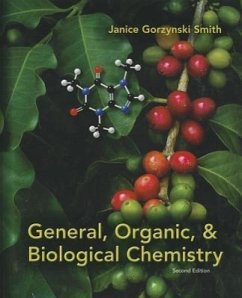Janice Smith
General, Organic, & Biological Chemistry
Janice Smith
General, Organic, & Biological Chemistry
- Gebundenes Buch
- Merkliste
- Auf die Merkliste
- Bewerten Bewerten
- Teilen
- Produkt teilen
- Produkterinnerung
- Produkterinnerung
This text is different--by design. By relating fundamental concepts of general, organic, and biological chemistry to the everyday world, Jan Smith effectively engages students with bulleted lists, extensive illustrations, and step-by-step problem solving. Smith writes with an approach that delivers need-to-know information in a succinct style for today's students. Armed with an excellent illustration program full of macro-to-micro art, as well as many applications to biological, medical, consumer, and environmental topics, this book is a powerhouse of learning for students.
Andere Kunden interessierten sich auch für
![Chemistry: An Introduction to General, Organic, and Biological Chemistry, Global Edition Chemistry: An Introduction to General, Organic, and Biological Chemistry, Global Edition]() Karen C. TimberlakeChemistry: An Introduction to General, Organic, and Biological Chemistry, Global Edition63,99 €
Karen C. TimberlakeChemistry: An Introduction to General, Organic, and Biological Chemistry, Global Edition63,99 €![Introduction to General, Organic, and Biochemistry Introduction to General, Organic, and Biochemistry]() Morris HeinIntroduction to General, Organic, and Biochemistry179,99 €
Morris HeinIntroduction to General, Organic, and Biochemistry179,99 €![Introduction to General, Organic, and Biochemistry Introduction to General, Organic, and Biochemistry]() Frederick BettelheimIntroduction to General, Organic, and Biochemistry109,99 €
Frederick BettelheimIntroduction to General, Organic, and Biochemistry109,99 €![Fundamentals of General, Organic and Biological Chemistry in SI Units Fundamentals of General, Organic and Biological Chemistry in SI Units]() Carl HoegerFundamentals of General, Organic and Biological Chemistry in SI Units107,99 €
Carl HoegerFundamentals of General, Organic and Biological Chemistry in SI Units107,99 €![Fundamentals of General, Organic and Biological Chemistry, SI Edition + Mastering Chemistry with Pearson eText (Package) Fundamentals of General, Organic and Biological Chemistry, SI Edition + Mastering Chemistry with Pearson eText (Package)]() Carl HoegerFundamentals of General, Organic and Biological Chemistry, SI Edition + Mastering Chemistry with Pearson eText (Package)96,99 €
Carl HoegerFundamentals of General, Organic and Biological Chemistry, SI Edition + Mastering Chemistry with Pearson eText (Package)96,99 €![Basic Nomenclature, Organic, Inorganic, Chemistry Basic Nomenclature, Organic, Inorganic, Chemistry]() Ugbe Fabian AuduBasic Nomenclature, Organic, Inorganic, Chemistry40,99 €
Ugbe Fabian AuduBasic Nomenclature, Organic, Inorganic, Chemistry40,99 €![Biological Functions of Carbohydrates Biological Functions of Carbohydrates]() D. J. CandyBiological Functions of Carbohydrates42,99 €
D. J. CandyBiological Functions of Carbohydrates42,99 €-
-
-
This text is different--by design. By relating fundamental concepts of general, organic, and biological chemistry to the everyday world, Jan Smith effectively engages students with bulleted lists, extensive illustrations, and step-by-step problem solving. Smith writes with an approach that delivers need-to-know information in a succinct style for today's students. Armed with an excellent illustration program full of macro-to-micro art, as well as many applications to biological, medical, consumer, and environmental topics, this book is a powerhouse of learning for students.
Hinweis: Dieser Artikel kann nur an eine deutsche Lieferadresse ausgeliefert werden.
Hinweis: Dieser Artikel kann nur an eine deutsche Lieferadresse ausgeliefert werden.
Produktdetails
- Produktdetails
- Verlag: McGraw Hill LLC
- Revised
- Seitenzahl: 944
- Altersempfehlung: ab 18 Jahre
- Erscheinungstermin: Januar 2012
- Englisch
- Abmessung: 277mm x 231mm x 36mm
- Gewicht: 2259g
- ISBN-13: 9780073402789
- ISBN-10: 0073402788
- Artikelnr.: 34920662
- Herstellerkennzeichnung
- Libri GmbH
- Europaallee 1
- 36244 Bad Hersfeld
- gpsr@libri.de
- Verlag: McGraw Hill LLC
- Revised
- Seitenzahl: 944
- Altersempfehlung: ab 18 Jahre
- Erscheinungstermin: Januar 2012
- Englisch
- Abmessung: 277mm x 231mm x 36mm
- Gewicht: 2259g
- ISBN-13: 9780073402789
- ISBN-10: 0073402788
- Artikelnr.: 34920662
- Herstellerkennzeichnung
- Libri GmbH
- Europaallee 1
- 36244 Bad Hersfeld
- gpsr@libri.de
Chapter 1: Matter and Measurement
1.1 Chemistry-The Science of Everyday Experience
1.2States of Matter
1.3Classification of Matter
1.4Measurement
1.5Significant Figures
1.6Scientific Notation
1.7Problem Solving Using the Factor-Label Method
1.8Focus on Health and Medicine: Problem Solving Using Clinical Conversion
Factors
1.9Temperature
1.10 Density and Specific Gravity
Chapter 2: Atoms and the Periodic Table
2.1Elements
2.2Structure of the Atom
2.3Isotopes
2.4The Periodic Table
2.5Electronic Structure
2.6Electronic Configurations
2.7Valence Electrons
2.8Periodic Trends
Chapter 3: Ionic Compounds
3.1Introduction to Bonding
3.2Ions
3.3Ionic Compounds
3.4Naming Ionic Compounds
3.5Physical Properties of Ionic Compounds
3.6Polyatomic Ions
Chapter 4: Covalent Compounds
4.1Introduction to Covalent Bonding
4.2Lewis Structures
4.3Exceptions to the Octet Rule
4.4Resonance
4.5Naming Covalent Compounds
4.6Molecular Shape
4.7Electronegativity and Bond Polarity
4.8Polarity of Molecules
4.9Focus on Health and Medicine: Covalent Drugs and Medical Products
Chapter 5: Chemical Reactions
5.1Introduction to Chemical Reactions
5.2Balancing Chemical Equations
5.3The Mole and Avogadro's Number
5.4Mass to Mole Conversions
5.5Mole Calculations in Chemical Equations
5.6Mass Calculations in Chemical Equations
5.7Percent Yield
5.8Limiting Reactants
5.9Oxidation and Reduction
5.10 Focus on Health and Medicine: Pacemakers
Chapter 6: Energy Changes, Reaction Rates, and Equilibrium
6.1Energy
6.2Energy Changes in Reactions
6.3Energy Diagrams
6.4Reaction Rates
6.5Equilibrium
6.6Le Châtelier's Principle
6.7Focus on the Human Body: Body Temperature
Chapter 7: Gases, Liquids, and Solids
7.1The Three States of Matter
7.2Gases and Pressure
7.3Gas Laws That Relate Pressure, Volume, and Temperature
7.4Avogadro's Law-How Volume and Moles Are Related
7.5The Ideal Gas Law
7.6Dalton's Law and Partial Pressures
7.7Intermolecular Forces, Boiling Point, and Melting Point
7.8The Liquid State
7.9The Solid State
7.10 Energy and Phase Changes
7.11 Heating and Cooling Curves
Chapter 8: Solutions
8.1Introduction
8.2Solubility-General Features
8.3Solubility-Effects of Temperature and Pressure
8.4Concentration Units-Percent Concentration
8.5Concentration Units-Molarity
8.6Dilution
8.7Colligative Properties
8.8Osmosis and Dialysis
Chapter 9: Acids and Bases
9.1Introduction to Acids and Bases
9.2The Reaction of a Brønsted-Lowry Acid with a Brønsted-Lowry Base
9.3Acid and Base Strength
9.4Equilibrium and Acid Dissociation Constants
9.5Dissociation of Water
9.6The pH Scale
9.7Common Acid-Base Reactions
9.8The Acidity and Basicity of Salt Solutions
9.9Titration
9.10 Buffers
9.11 Focus on the Human Body: Buffers in the Blood
Chapter 10: Nuclear Chemistry
10.1 Introduction
10.2 Nuclear Reactions
10.3 Half-Life
10.4 Detecting and Measuring Radiation
10.5 Focus on Health and Medicine: Medical Uses of Radioisotopes
10.6 Nuclear Fission and Nuclear Fusion
10.7 Focus on Health and Medicine: Medical Imaging Without Radioactivity
Chapter 11: Introduction to Organic Molecules and Functional Groups
11.1 Introduction to Organic Chemistry
11.2 Characteristic Features of Organic Compounds
11.3 Shapes of Organic Molecules
11.4 Drawing Organic Molecules
11.5 Functional Groups
11.6 Properties of Organic Compounds
11.7 Focus on Health and Medicine: Vitamins
Chapter 12: Alkanes
12.1 Introduction
12.2 Simple Alkanes
12.3 An Introduction to Nomenclature
12.4 Alkane Nomenclature
12.5 Cycloalkanes
12.6 Focus on the Environment-Fossil Fuels
12.7 Physical Properties
12.8 Focus on the Environment: Combustion
Chapter 13: Unsaturated Hydrocarbons
13.1 Alkenes and Alkynes
13.2 Nomenclature of Alkenes and Alkynes
13.3 Cis-Trans Isomers
13.4 Interesting Alkenes in Food and Medicine
13.5 Focus on Health and Medicine: Oral Contraceptives
13.6 Reactions of Alkenes
13.7 Focus on Health and Medicine: Margarine or Butter?
13.8 Polymers-The Fabric of Modern Society
13.9 Aromatic Compounds
13.10 Nomenclature of Benzene Derivatives
13.11 Focus on Health and Medicine: Aromatic Drugs, Sunscreens, and
Carcinogens
13.12 Focus on Health and Medicine: Phenols and Antioxidants
13.13 Reactions of Aromatic Compounds
Chapter 14: Organic Compounds that Contain Oxygen, Halogen, or Sulfur
14.1 Introduction
14.2 Structure and Properties of Alcohols
14.3 Nomenclature of Alcohols
14.4 Interesting Alcohols
14.5 Reactions of Alcohols
14.6 Focus on Health and Medicine: Ethanol, the Most Widely Abused Drug
14.7 Structure and Properties of Ethers
14.8 Focus on Health and Medicine: Ethers as Anesthetics
14.9 Alkyl Halides
14.10 Organic Compounds That Contain Sulfur
Chapter 15: The Three-Dimensional Shape of Molecules
15.1 Isomers-A Review
15.2 Looking Glass Chemistry-Molecules and Their Mirror Images
15.3 Chirality Centers
15.4 Chirality Centers in Cyclic Compounds
15.5 Focus on Health and Medicine: Chiral Drugs
15.6 Fischer Projections
15.7 Optical Activity
15.8 Compounds With Two or More Chirality Centers
15.9 Focus on the Human Body: The Sense of Smell
Chapter 16: Aldehydes and Ketones
16.1 Structure and Bonding
16.2 Nomenclature
16.3 Physical Properties
16.4 Focus on Health and Medicine: Interesting Aldehydes and Ketones
16.5 Reactions of Aldehydes and Ketones
16.6 Reduction of Aldehydes and Ketones
16.7 Focus on the Human Body: The Chemistry of Vision
16.8 Acetal Formation
Chapter 17: Carboxylic Acids, Esters, and Amides
17.1 Structure and Bonding
17.2 Nomenclature
17.3 Physical Properties
17.4 Interesting Carboxylic Acids in Consumer Products and Medicines
17.5 Interesting Esters and Amides
17.6 The Acidity of Carboxylic Acids
17.7 Focus on Health and Medicine: Aspirin
17.8 The Conversion of Carboxylic Acids to Esters and Amides
17.9 Hydrolysis of Esters and Amides
17.10 Synthetic Polymers in Modern Society-Polyamides and Polyesters
17.11 Focus on Health and Medicine: Penicillin
Chapter 18: Amines and Neurotransmitters
18.1 Structure and Bonding
18.2 Nomenclature
18.3 Physical Properties
18.4 Focus on Health and Medicine: Caffeine and Nicotine
18.5 Alkaloids-Amines from Plant Sources
18.6 Amines as Bases
18.7 Focus on Health and Medicine: Ammonium Salts as Useful Drugs
18.8 Neurotransmitters
18.9 Focus on the Human Body: Epinephrine and Related Compounds
18.10 Focus on Health and Medicine: Histamines and Antihistamines
Chapter 19: Lipids
19.1 Introduction to Lipids
19.2 Fatty Acids
19.3 Waxes
19.4 Triacylglycerols-Fats and Oils
19.5 Hydrolysis of Triacylglycerols
19.6 Phospholipids
19.7 Cell Membranes
19.8 Focus on Health and Medicine: Cholesterol, the Most Prominent Steroid
19.9 Steroid Hormones
19.10 Focus on Health and Medicine: Fat-Soluble Vitamins
19.11 Focus on Health and Medicine: Prostaglandins and Leukotrienes
Chapter 20: Carbohydrates
20.1 Introduction
20.2 Monosaccharides
20.3 The Cyclic Forms of Monosaccharides
20.4 Reduction and Oxidation of Monosaccharides
20.5 Disaccharides
20.6 Polysaccharides
20.7 Focus on the Human Body: Useful Carbohydrate Derivatives
20.8 Focus on the Human Body: Blood Types
Chapter 21: Amino Acids, Proteins, and Enzymes
21.1 Introduction
21.2 Amino Acids
21.3 Acid-Base Behavior of Amino Acids
21.4 Peptides
21.5 Focus on the Human Body: Biologically Active Peptides
21.6 Proteins
21.7 Focus on the Human Body: Common Proteins
21.8 Protein Hydrolysis and Denaturation
21.9 Enzymes
21.10 Focus on Health and Medicine: Using Enzymes to Diagnose and Treat
Disease
Chapter 22: Nucleic Acids and Protein Synthesis
22.1 Nucleosides and Nucleotides
22.2 Nucleic Acids
22.3 The DNA Double Helix
22.4 Replication
22.5 RNA
22.6 Transcription
22.7 Genetic Code
22.8 Translation and Protein Synthesis
22.9 Mutations and Genetic Diseases
22.10 Recombinant DNA
22.11 Focus on Health and Medicine: Viruses
Chapter 23: Digestion and the Conversion of Food into Energy
23.1 Introduction
23.2 An Overview of Metabolism
23.3 ATP and Energy Production
23.4 Coenzymes in Metab olism
23.5 The Citric Acid Cycle
23.6 The Electron Transport Chain and Oxidative Phosphorylation
23.7 Focus on Health and Medicine: Hydrogen Cyanide
Chapter 24: Carbohydrate, Lipid, and Protein Metabolism
24.1 Introduction
24.2 Understanding Biochemical Reactions
24.3 Glycolysis
24.4 The Fate of Pyruvate
24.5 The ATP Yield from Glucose
24.6 Gluconeogenesis
24.7 The Catabolism of Triacylglycerols
24.8 Ketone Bodies
24.9 Amino Acid Metabolism
1.1 Chemistry-The Science of Everyday Experience
1.2States of Matter
1.3Classification of Matter
1.4Measurement
1.5Significant Figures
1.6Scientific Notation
1.7Problem Solving Using the Factor-Label Method
1.8Focus on Health and Medicine: Problem Solving Using Clinical Conversion
Factors
1.9Temperature
1.10 Density and Specific Gravity
Chapter 2: Atoms and the Periodic Table
2.1Elements
2.2Structure of the Atom
2.3Isotopes
2.4The Periodic Table
2.5Electronic Structure
2.6Electronic Configurations
2.7Valence Electrons
2.8Periodic Trends
Chapter 3: Ionic Compounds
3.1Introduction to Bonding
3.2Ions
3.3Ionic Compounds
3.4Naming Ionic Compounds
3.5Physical Properties of Ionic Compounds
3.6Polyatomic Ions
Chapter 4: Covalent Compounds
4.1Introduction to Covalent Bonding
4.2Lewis Structures
4.3Exceptions to the Octet Rule
4.4Resonance
4.5Naming Covalent Compounds
4.6Molecular Shape
4.7Electronegativity and Bond Polarity
4.8Polarity of Molecules
4.9Focus on Health and Medicine: Covalent Drugs and Medical Products
Chapter 5: Chemical Reactions
5.1Introduction to Chemical Reactions
5.2Balancing Chemical Equations
5.3The Mole and Avogadro's Number
5.4Mass to Mole Conversions
5.5Mole Calculations in Chemical Equations
5.6Mass Calculations in Chemical Equations
5.7Percent Yield
5.8Limiting Reactants
5.9Oxidation and Reduction
5.10 Focus on Health and Medicine: Pacemakers
Chapter 6: Energy Changes, Reaction Rates, and Equilibrium
6.1Energy
6.2Energy Changes in Reactions
6.3Energy Diagrams
6.4Reaction Rates
6.5Equilibrium
6.6Le Châtelier's Principle
6.7Focus on the Human Body: Body Temperature
Chapter 7: Gases, Liquids, and Solids
7.1The Three States of Matter
7.2Gases and Pressure
7.3Gas Laws That Relate Pressure, Volume, and Temperature
7.4Avogadro's Law-How Volume and Moles Are Related
7.5The Ideal Gas Law
7.6Dalton's Law and Partial Pressures
7.7Intermolecular Forces, Boiling Point, and Melting Point
7.8The Liquid State
7.9The Solid State
7.10 Energy and Phase Changes
7.11 Heating and Cooling Curves
Chapter 8: Solutions
8.1Introduction
8.2Solubility-General Features
8.3Solubility-Effects of Temperature and Pressure
8.4Concentration Units-Percent Concentration
8.5Concentration Units-Molarity
8.6Dilution
8.7Colligative Properties
8.8Osmosis and Dialysis
Chapter 9: Acids and Bases
9.1Introduction to Acids and Bases
9.2The Reaction of a Brønsted-Lowry Acid with a Brønsted-Lowry Base
9.3Acid and Base Strength
9.4Equilibrium and Acid Dissociation Constants
9.5Dissociation of Water
9.6The pH Scale
9.7Common Acid-Base Reactions
9.8The Acidity and Basicity of Salt Solutions
9.9Titration
9.10 Buffers
9.11 Focus on the Human Body: Buffers in the Blood
Chapter 10: Nuclear Chemistry
10.1 Introduction
10.2 Nuclear Reactions
10.3 Half-Life
10.4 Detecting and Measuring Radiation
10.5 Focus on Health and Medicine: Medical Uses of Radioisotopes
10.6 Nuclear Fission and Nuclear Fusion
10.7 Focus on Health and Medicine: Medical Imaging Without Radioactivity
Chapter 11: Introduction to Organic Molecules and Functional Groups
11.1 Introduction to Organic Chemistry
11.2 Characteristic Features of Organic Compounds
11.3 Shapes of Organic Molecules
11.4 Drawing Organic Molecules
11.5 Functional Groups
11.6 Properties of Organic Compounds
11.7 Focus on Health and Medicine: Vitamins
Chapter 12: Alkanes
12.1 Introduction
12.2 Simple Alkanes
12.3 An Introduction to Nomenclature
12.4 Alkane Nomenclature
12.5 Cycloalkanes
12.6 Focus on the Environment-Fossil Fuels
12.7 Physical Properties
12.8 Focus on the Environment: Combustion
Chapter 13: Unsaturated Hydrocarbons
13.1 Alkenes and Alkynes
13.2 Nomenclature of Alkenes and Alkynes
13.3 Cis-Trans Isomers
13.4 Interesting Alkenes in Food and Medicine
13.5 Focus on Health and Medicine: Oral Contraceptives
13.6 Reactions of Alkenes
13.7 Focus on Health and Medicine: Margarine or Butter?
13.8 Polymers-The Fabric of Modern Society
13.9 Aromatic Compounds
13.10 Nomenclature of Benzene Derivatives
13.11 Focus on Health and Medicine: Aromatic Drugs, Sunscreens, and
Carcinogens
13.12 Focus on Health and Medicine: Phenols and Antioxidants
13.13 Reactions of Aromatic Compounds
Chapter 14: Organic Compounds that Contain Oxygen, Halogen, or Sulfur
14.1 Introduction
14.2 Structure and Properties of Alcohols
14.3 Nomenclature of Alcohols
14.4 Interesting Alcohols
14.5 Reactions of Alcohols
14.6 Focus on Health and Medicine: Ethanol, the Most Widely Abused Drug
14.7 Structure and Properties of Ethers
14.8 Focus on Health and Medicine: Ethers as Anesthetics
14.9 Alkyl Halides
14.10 Organic Compounds That Contain Sulfur
Chapter 15: The Three-Dimensional Shape of Molecules
15.1 Isomers-A Review
15.2 Looking Glass Chemistry-Molecules and Their Mirror Images
15.3 Chirality Centers
15.4 Chirality Centers in Cyclic Compounds
15.5 Focus on Health and Medicine: Chiral Drugs
15.6 Fischer Projections
15.7 Optical Activity
15.8 Compounds With Two or More Chirality Centers
15.9 Focus on the Human Body: The Sense of Smell
Chapter 16: Aldehydes and Ketones
16.1 Structure and Bonding
16.2 Nomenclature
16.3 Physical Properties
16.4 Focus on Health and Medicine: Interesting Aldehydes and Ketones
16.5 Reactions of Aldehydes and Ketones
16.6 Reduction of Aldehydes and Ketones
16.7 Focus on the Human Body: The Chemistry of Vision
16.8 Acetal Formation
Chapter 17: Carboxylic Acids, Esters, and Amides
17.1 Structure and Bonding
17.2 Nomenclature
17.3 Physical Properties
17.4 Interesting Carboxylic Acids in Consumer Products and Medicines
17.5 Interesting Esters and Amides
17.6 The Acidity of Carboxylic Acids
17.7 Focus on Health and Medicine: Aspirin
17.8 The Conversion of Carboxylic Acids to Esters and Amides
17.9 Hydrolysis of Esters and Amides
17.10 Synthetic Polymers in Modern Society-Polyamides and Polyesters
17.11 Focus on Health and Medicine: Penicillin
Chapter 18: Amines and Neurotransmitters
18.1 Structure and Bonding
18.2 Nomenclature
18.3 Physical Properties
18.4 Focus on Health and Medicine: Caffeine and Nicotine
18.5 Alkaloids-Amines from Plant Sources
18.6 Amines as Bases
18.7 Focus on Health and Medicine: Ammonium Salts as Useful Drugs
18.8 Neurotransmitters
18.9 Focus on the Human Body: Epinephrine and Related Compounds
18.10 Focus on Health and Medicine: Histamines and Antihistamines
Chapter 19: Lipids
19.1 Introduction to Lipids
19.2 Fatty Acids
19.3 Waxes
19.4 Triacylglycerols-Fats and Oils
19.5 Hydrolysis of Triacylglycerols
19.6 Phospholipids
19.7 Cell Membranes
19.8 Focus on Health and Medicine: Cholesterol, the Most Prominent Steroid
19.9 Steroid Hormones
19.10 Focus on Health and Medicine: Fat-Soluble Vitamins
19.11 Focus on Health and Medicine: Prostaglandins and Leukotrienes
Chapter 20: Carbohydrates
20.1 Introduction
20.2 Monosaccharides
20.3 The Cyclic Forms of Monosaccharides
20.4 Reduction and Oxidation of Monosaccharides
20.5 Disaccharides
20.6 Polysaccharides
20.7 Focus on the Human Body: Useful Carbohydrate Derivatives
20.8 Focus on the Human Body: Blood Types
Chapter 21: Amino Acids, Proteins, and Enzymes
21.1 Introduction
21.2 Amino Acids
21.3 Acid-Base Behavior of Amino Acids
21.4 Peptides
21.5 Focus on the Human Body: Biologically Active Peptides
21.6 Proteins
21.7 Focus on the Human Body: Common Proteins
21.8 Protein Hydrolysis and Denaturation
21.9 Enzymes
21.10 Focus on Health and Medicine: Using Enzymes to Diagnose and Treat
Disease
Chapter 22: Nucleic Acids and Protein Synthesis
22.1 Nucleosides and Nucleotides
22.2 Nucleic Acids
22.3 The DNA Double Helix
22.4 Replication
22.5 RNA
22.6 Transcription
22.7 Genetic Code
22.8 Translation and Protein Synthesis
22.9 Mutations and Genetic Diseases
22.10 Recombinant DNA
22.11 Focus on Health and Medicine: Viruses
Chapter 23: Digestion and the Conversion of Food into Energy
23.1 Introduction
23.2 An Overview of Metabolism
23.3 ATP and Energy Production
23.4 Coenzymes in Metab olism
23.5 The Citric Acid Cycle
23.6 The Electron Transport Chain and Oxidative Phosphorylation
23.7 Focus on Health and Medicine: Hydrogen Cyanide
Chapter 24: Carbohydrate, Lipid, and Protein Metabolism
24.1 Introduction
24.2 Understanding Biochemical Reactions
24.3 Glycolysis
24.4 The Fate of Pyruvate
24.5 The ATP Yield from Glucose
24.6 Gluconeogenesis
24.7 The Catabolism of Triacylglycerols
24.8 Ketone Bodies
24.9 Amino Acid Metabolism
Chapter 1: Matter and Measurement
1.1 Chemistry-The Science of Everyday Experience
1.2States of Matter
1.3Classification of Matter
1.4Measurement
1.5Significant Figures
1.6Scientific Notation
1.7Problem Solving Using the Factor-Label Method
1.8Focus on Health and Medicine: Problem Solving Using Clinical Conversion
Factors
1.9Temperature
1.10 Density and Specific Gravity
Chapter 2: Atoms and the Periodic Table
2.1Elements
2.2Structure of the Atom
2.3Isotopes
2.4The Periodic Table
2.5Electronic Structure
2.6Electronic Configurations
2.7Valence Electrons
2.8Periodic Trends
Chapter 3: Ionic Compounds
3.1Introduction to Bonding
3.2Ions
3.3Ionic Compounds
3.4Naming Ionic Compounds
3.5Physical Properties of Ionic Compounds
3.6Polyatomic Ions
Chapter 4: Covalent Compounds
4.1Introduction to Covalent Bonding
4.2Lewis Structures
4.3Exceptions to the Octet Rule
4.4Resonance
4.5Naming Covalent Compounds
4.6Molecular Shape
4.7Electronegativity and Bond Polarity
4.8Polarity of Molecules
4.9Focus on Health and Medicine: Covalent Drugs and Medical Products
Chapter 5: Chemical Reactions
5.1Introduction to Chemical Reactions
5.2Balancing Chemical Equations
5.3The Mole and Avogadro's Number
5.4Mass to Mole Conversions
5.5Mole Calculations in Chemical Equations
5.6Mass Calculations in Chemical Equations
5.7Percent Yield
5.8Limiting Reactants
5.9Oxidation and Reduction
5.10 Focus on Health and Medicine: Pacemakers
Chapter 6: Energy Changes, Reaction Rates, and Equilibrium
6.1Energy
6.2Energy Changes in Reactions
6.3Energy Diagrams
6.4Reaction Rates
6.5Equilibrium
6.6Le Châtelier's Principle
6.7Focus on the Human Body: Body Temperature
Chapter 7: Gases, Liquids, and Solids
7.1The Three States of Matter
7.2Gases and Pressure
7.3Gas Laws That Relate Pressure, Volume, and Temperature
7.4Avogadro's Law-How Volume and Moles Are Related
7.5The Ideal Gas Law
7.6Dalton's Law and Partial Pressures
7.7Intermolecular Forces, Boiling Point, and Melting Point
7.8The Liquid State
7.9The Solid State
7.10 Energy and Phase Changes
7.11 Heating and Cooling Curves
Chapter 8: Solutions
8.1Introduction
8.2Solubility-General Features
8.3Solubility-Effects of Temperature and Pressure
8.4Concentration Units-Percent Concentration
8.5Concentration Units-Molarity
8.6Dilution
8.7Colligative Properties
8.8Osmosis and Dialysis
Chapter 9: Acids and Bases
9.1Introduction to Acids and Bases
9.2The Reaction of a Brønsted-Lowry Acid with a Brønsted-Lowry Base
9.3Acid and Base Strength
9.4Equilibrium and Acid Dissociation Constants
9.5Dissociation of Water
9.6The pH Scale
9.7Common Acid-Base Reactions
9.8The Acidity and Basicity of Salt Solutions
9.9Titration
9.10 Buffers
9.11 Focus on the Human Body: Buffers in the Blood
Chapter 10: Nuclear Chemistry
10.1 Introduction
10.2 Nuclear Reactions
10.3 Half-Life
10.4 Detecting and Measuring Radiation
10.5 Focus on Health and Medicine: Medical Uses of Radioisotopes
10.6 Nuclear Fission and Nuclear Fusion
10.7 Focus on Health and Medicine: Medical Imaging Without Radioactivity
Chapter 11: Introduction to Organic Molecules and Functional Groups
11.1 Introduction to Organic Chemistry
11.2 Characteristic Features of Organic Compounds
11.3 Shapes of Organic Molecules
11.4 Drawing Organic Molecules
11.5 Functional Groups
11.6 Properties of Organic Compounds
11.7 Focus on Health and Medicine: Vitamins
Chapter 12: Alkanes
12.1 Introduction
12.2 Simple Alkanes
12.3 An Introduction to Nomenclature
12.4 Alkane Nomenclature
12.5 Cycloalkanes
12.6 Focus on the Environment-Fossil Fuels
12.7 Physical Properties
12.8 Focus on the Environment: Combustion
Chapter 13: Unsaturated Hydrocarbons
13.1 Alkenes and Alkynes
13.2 Nomenclature of Alkenes and Alkynes
13.3 Cis-Trans Isomers
13.4 Interesting Alkenes in Food and Medicine
13.5 Focus on Health and Medicine: Oral Contraceptives
13.6 Reactions of Alkenes
13.7 Focus on Health and Medicine: Margarine or Butter?
13.8 Polymers-The Fabric of Modern Society
13.9 Aromatic Compounds
13.10 Nomenclature of Benzene Derivatives
13.11 Focus on Health and Medicine: Aromatic Drugs, Sunscreens, and
Carcinogens
13.12 Focus on Health and Medicine: Phenols and Antioxidants
13.13 Reactions of Aromatic Compounds
Chapter 14: Organic Compounds that Contain Oxygen, Halogen, or Sulfur
14.1 Introduction
14.2 Structure and Properties of Alcohols
14.3 Nomenclature of Alcohols
14.4 Interesting Alcohols
14.5 Reactions of Alcohols
14.6 Focus on Health and Medicine: Ethanol, the Most Widely Abused Drug
14.7 Structure and Properties of Ethers
14.8 Focus on Health and Medicine: Ethers as Anesthetics
14.9 Alkyl Halides
14.10 Organic Compounds That Contain Sulfur
Chapter 15: The Three-Dimensional Shape of Molecules
15.1 Isomers-A Review
15.2 Looking Glass Chemistry-Molecules and Their Mirror Images
15.3 Chirality Centers
15.4 Chirality Centers in Cyclic Compounds
15.5 Focus on Health and Medicine: Chiral Drugs
15.6 Fischer Projections
15.7 Optical Activity
15.8 Compounds With Two or More Chirality Centers
15.9 Focus on the Human Body: The Sense of Smell
Chapter 16: Aldehydes and Ketones
16.1 Structure and Bonding
16.2 Nomenclature
16.3 Physical Properties
16.4 Focus on Health and Medicine: Interesting Aldehydes and Ketones
16.5 Reactions of Aldehydes and Ketones
16.6 Reduction of Aldehydes and Ketones
16.7 Focus on the Human Body: The Chemistry of Vision
16.8 Acetal Formation
Chapter 17: Carboxylic Acids, Esters, and Amides
17.1 Structure and Bonding
17.2 Nomenclature
17.3 Physical Properties
17.4 Interesting Carboxylic Acids in Consumer Products and Medicines
17.5 Interesting Esters and Amides
17.6 The Acidity of Carboxylic Acids
17.7 Focus on Health and Medicine: Aspirin
17.8 The Conversion of Carboxylic Acids to Esters and Amides
17.9 Hydrolysis of Esters and Amides
17.10 Synthetic Polymers in Modern Society-Polyamides and Polyesters
17.11 Focus on Health and Medicine: Penicillin
Chapter 18: Amines and Neurotransmitters
18.1 Structure and Bonding
18.2 Nomenclature
18.3 Physical Properties
18.4 Focus on Health and Medicine: Caffeine and Nicotine
18.5 Alkaloids-Amines from Plant Sources
18.6 Amines as Bases
18.7 Focus on Health and Medicine: Ammonium Salts as Useful Drugs
18.8 Neurotransmitters
18.9 Focus on the Human Body: Epinephrine and Related Compounds
18.10 Focus on Health and Medicine: Histamines and Antihistamines
Chapter 19: Lipids
19.1 Introduction to Lipids
19.2 Fatty Acids
19.3 Waxes
19.4 Triacylglycerols-Fats and Oils
19.5 Hydrolysis of Triacylglycerols
19.6 Phospholipids
19.7 Cell Membranes
19.8 Focus on Health and Medicine: Cholesterol, the Most Prominent Steroid
19.9 Steroid Hormones
19.10 Focus on Health and Medicine: Fat-Soluble Vitamins
19.11 Focus on Health and Medicine: Prostaglandins and Leukotrienes
Chapter 20: Carbohydrates
20.1 Introduction
20.2 Monosaccharides
20.3 The Cyclic Forms of Monosaccharides
20.4 Reduction and Oxidation of Monosaccharides
20.5 Disaccharides
20.6 Polysaccharides
20.7 Focus on the Human Body: Useful Carbohydrate Derivatives
20.8 Focus on the Human Body: Blood Types
Chapter 21: Amino Acids, Proteins, and Enzymes
21.1 Introduction
21.2 Amino Acids
21.3 Acid-Base Behavior of Amino Acids
21.4 Peptides
21.5 Focus on the Human Body: Biologically Active Peptides
21.6 Proteins
21.7 Focus on the Human Body: Common Proteins
21.8 Protein Hydrolysis and Denaturation
21.9 Enzymes
21.10 Focus on Health and Medicine: Using Enzymes to Diagnose and Treat
Disease
Chapter 22: Nucleic Acids and Protein Synthesis
22.1 Nucleosides and Nucleotides
22.2 Nucleic Acids
22.3 The DNA Double Helix
22.4 Replication
22.5 RNA
22.6 Transcription
22.7 Genetic Code
22.8 Translation and Protein Synthesis
22.9 Mutations and Genetic Diseases
22.10 Recombinant DNA
22.11 Focus on Health and Medicine: Viruses
Chapter 23: Digestion and the Conversion of Food into Energy
23.1 Introduction
23.2 An Overview of Metabolism
23.3 ATP and Energy Production
23.4 Coenzymes in Metab olism
23.5 The Citric Acid Cycle
23.6 The Electron Transport Chain and Oxidative Phosphorylation
23.7 Focus on Health and Medicine: Hydrogen Cyanide
Chapter 24: Carbohydrate, Lipid, and Protein Metabolism
24.1 Introduction
24.2 Understanding Biochemical Reactions
24.3 Glycolysis
24.4 The Fate of Pyruvate
24.5 The ATP Yield from Glucose
24.6 Gluconeogenesis
24.7 The Catabolism of Triacylglycerols
24.8 Ketone Bodies
24.9 Amino Acid Metabolism
1.1 Chemistry-The Science of Everyday Experience
1.2States of Matter
1.3Classification of Matter
1.4Measurement
1.5Significant Figures
1.6Scientific Notation
1.7Problem Solving Using the Factor-Label Method
1.8Focus on Health and Medicine: Problem Solving Using Clinical Conversion
Factors
1.9Temperature
1.10 Density and Specific Gravity
Chapter 2: Atoms and the Periodic Table
2.1Elements
2.2Structure of the Atom
2.3Isotopes
2.4The Periodic Table
2.5Electronic Structure
2.6Electronic Configurations
2.7Valence Electrons
2.8Periodic Trends
Chapter 3: Ionic Compounds
3.1Introduction to Bonding
3.2Ions
3.3Ionic Compounds
3.4Naming Ionic Compounds
3.5Physical Properties of Ionic Compounds
3.6Polyatomic Ions
Chapter 4: Covalent Compounds
4.1Introduction to Covalent Bonding
4.2Lewis Structures
4.3Exceptions to the Octet Rule
4.4Resonance
4.5Naming Covalent Compounds
4.6Molecular Shape
4.7Electronegativity and Bond Polarity
4.8Polarity of Molecules
4.9Focus on Health and Medicine: Covalent Drugs and Medical Products
Chapter 5: Chemical Reactions
5.1Introduction to Chemical Reactions
5.2Balancing Chemical Equations
5.3The Mole and Avogadro's Number
5.4Mass to Mole Conversions
5.5Mole Calculations in Chemical Equations
5.6Mass Calculations in Chemical Equations
5.7Percent Yield
5.8Limiting Reactants
5.9Oxidation and Reduction
5.10 Focus on Health and Medicine: Pacemakers
Chapter 6: Energy Changes, Reaction Rates, and Equilibrium
6.1Energy
6.2Energy Changes in Reactions
6.3Energy Diagrams
6.4Reaction Rates
6.5Equilibrium
6.6Le Châtelier's Principle
6.7Focus on the Human Body: Body Temperature
Chapter 7: Gases, Liquids, and Solids
7.1The Three States of Matter
7.2Gases and Pressure
7.3Gas Laws That Relate Pressure, Volume, and Temperature
7.4Avogadro's Law-How Volume and Moles Are Related
7.5The Ideal Gas Law
7.6Dalton's Law and Partial Pressures
7.7Intermolecular Forces, Boiling Point, and Melting Point
7.8The Liquid State
7.9The Solid State
7.10 Energy and Phase Changes
7.11 Heating and Cooling Curves
Chapter 8: Solutions
8.1Introduction
8.2Solubility-General Features
8.3Solubility-Effects of Temperature and Pressure
8.4Concentration Units-Percent Concentration
8.5Concentration Units-Molarity
8.6Dilution
8.7Colligative Properties
8.8Osmosis and Dialysis
Chapter 9: Acids and Bases
9.1Introduction to Acids and Bases
9.2The Reaction of a Brønsted-Lowry Acid with a Brønsted-Lowry Base
9.3Acid and Base Strength
9.4Equilibrium and Acid Dissociation Constants
9.5Dissociation of Water
9.6The pH Scale
9.7Common Acid-Base Reactions
9.8The Acidity and Basicity of Salt Solutions
9.9Titration
9.10 Buffers
9.11 Focus on the Human Body: Buffers in the Blood
Chapter 10: Nuclear Chemistry
10.1 Introduction
10.2 Nuclear Reactions
10.3 Half-Life
10.4 Detecting and Measuring Radiation
10.5 Focus on Health and Medicine: Medical Uses of Radioisotopes
10.6 Nuclear Fission and Nuclear Fusion
10.7 Focus on Health and Medicine: Medical Imaging Without Radioactivity
Chapter 11: Introduction to Organic Molecules and Functional Groups
11.1 Introduction to Organic Chemistry
11.2 Characteristic Features of Organic Compounds
11.3 Shapes of Organic Molecules
11.4 Drawing Organic Molecules
11.5 Functional Groups
11.6 Properties of Organic Compounds
11.7 Focus on Health and Medicine: Vitamins
Chapter 12: Alkanes
12.1 Introduction
12.2 Simple Alkanes
12.3 An Introduction to Nomenclature
12.4 Alkane Nomenclature
12.5 Cycloalkanes
12.6 Focus on the Environment-Fossil Fuels
12.7 Physical Properties
12.8 Focus on the Environment: Combustion
Chapter 13: Unsaturated Hydrocarbons
13.1 Alkenes and Alkynes
13.2 Nomenclature of Alkenes and Alkynes
13.3 Cis-Trans Isomers
13.4 Interesting Alkenes in Food and Medicine
13.5 Focus on Health and Medicine: Oral Contraceptives
13.6 Reactions of Alkenes
13.7 Focus on Health and Medicine: Margarine or Butter?
13.8 Polymers-The Fabric of Modern Society
13.9 Aromatic Compounds
13.10 Nomenclature of Benzene Derivatives
13.11 Focus on Health and Medicine: Aromatic Drugs, Sunscreens, and
Carcinogens
13.12 Focus on Health and Medicine: Phenols and Antioxidants
13.13 Reactions of Aromatic Compounds
Chapter 14: Organic Compounds that Contain Oxygen, Halogen, or Sulfur
14.1 Introduction
14.2 Structure and Properties of Alcohols
14.3 Nomenclature of Alcohols
14.4 Interesting Alcohols
14.5 Reactions of Alcohols
14.6 Focus on Health and Medicine: Ethanol, the Most Widely Abused Drug
14.7 Structure and Properties of Ethers
14.8 Focus on Health and Medicine: Ethers as Anesthetics
14.9 Alkyl Halides
14.10 Organic Compounds That Contain Sulfur
Chapter 15: The Three-Dimensional Shape of Molecules
15.1 Isomers-A Review
15.2 Looking Glass Chemistry-Molecules and Their Mirror Images
15.3 Chirality Centers
15.4 Chirality Centers in Cyclic Compounds
15.5 Focus on Health and Medicine: Chiral Drugs
15.6 Fischer Projections
15.7 Optical Activity
15.8 Compounds With Two or More Chirality Centers
15.9 Focus on the Human Body: The Sense of Smell
Chapter 16: Aldehydes and Ketones
16.1 Structure and Bonding
16.2 Nomenclature
16.3 Physical Properties
16.4 Focus on Health and Medicine: Interesting Aldehydes and Ketones
16.5 Reactions of Aldehydes and Ketones
16.6 Reduction of Aldehydes and Ketones
16.7 Focus on the Human Body: The Chemistry of Vision
16.8 Acetal Formation
Chapter 17: Carboxylic Acids, Esters, and Amides
17.1 Structure and Bonding
17.2 Nomenclature
17.3 Physical Properties
17.4 Interesting Carboxylic Acids in Consumer Products and Medicines
17.5 Interesting Esters and Amides
17.6 The Acidity of Carboxylic Acids
17.7 Focus on Health and Medicine: Aspirin
17.8 The Conversion of Carboxylic Acids to Esters and Amides
17.9 Hydrolysis of Esters and Amides
17.10 Synthetic Polymers in Modern Society-Polyamides and Polyesters
17.11 Focus on Health and Medicine: Penicillin
Chapter 18: Amines and Neurotransmitters
18.1 Structure and Bonding
18.2 Nomenclature
18.3 Physical Properties
18.4 Focus on Health and Medicine: Caffeine and Nicotine
18.5 Alkaloids-Amines from Plant Sources
18.6 Amines as Bases
18.7 Focus on Health and Medicine: Ammonium Salts as Useful Drugs
18.8 Neurotransmitters
18.9 Focus on the Human Body: Epinephrine and Related Compounds
18.10 Focus on Health and Medicine: Histamines and Antihistamines
Chapter 19: Lipids
19.1 Introduction to Lipids
19.2 Fatty Acids
19.3 Waxes
19.4 Triacylglycerols-Fats and Oils
19.5 Hydrolysis of Triacylglycerols
19.6 Phospholipids
19.7 Cell Membranes
19.8 Focus on Health and Medicine: Cholesterol, the Most Prominent Steroid
19.9 Steroid Hormones
19.10 Focus on Health and Medicine: Fat-Soluble Vitamins
19.11 Focus on Health and Medicine: Prostaglandins and Leukotrienes
Chapter 20: Carbohydrates
20.1 Introduction
20.2 Monosaccharides
20.3 The Cyclic Forms of Monosaccharides
20.4 Reduction and Oxidation of Monosaccharides
20.5 Disaccharides
20.6 Polysaccharides
20.7 Focus on the Human Body: Useful Carbohydrate Derivatives
20.8 Focus on the Human Body: Blood Types
Chapter 21: Amino Acids, Proteins, and Enzymes
21.1 Introduction
21.2 Amino Acids
21.3 Acid-Base Behavior of Amino Acids
21.4 Peptides
21.5 Focus on the Human Body: Biologically Active Peptides
21.6 Proteins
21.7 Focus on the Human Body: Common Proteins
21.8 Protein Hydrolysis and Denaturation
21.9 Enzymes
21.10 Focus on Health and Medicine: Using Enzymes to Diagnose and Treat
Disease
Chapter 22: Nucleic Acids and Protein Synthesis
22.1 Nucleosides and Nucleotides
22.2 Nucleic Acids
22.3 The DNA Double Helix
22.4 Replication
22.5 RNA
22.6 Transcription
22.7 Genetic Code
22.8 Translation and Protein Synthesis
22.9 Mutations and Genetic Diseases
22.10 Recombinant DNA
22.11 Focus on Health and Medicine: Viruses
Chapter 23: Digestion and the Conversion of Food into Energy
23.1 Introduction
23.2 An Overview of Metabolism
23.3 ATP and Energy Production
23.4 Coenzymes in Metab olism
23.5 The Citric Acid Cycle
23.6 The Electron Transport Chain and Oxidative Phosphorylation
23.7 Focus on Health and Medicine: Hydrogen Cyanide
Chapter 24: Carbohydrate, Lipid, and Protein Metabolism
24.1 Introduction
24.2 Understanding Biochemical Reactions
24.3 Glycolysis
24.4 The Fate of Pyruvate
24.5 The ATP Yield from Glucose
24.6 Gluconeogenesis
24.7 The Catabolism of Triacylglycerols
24.8 Ketone Bodies
24.9 Amino Acid Metabolism








